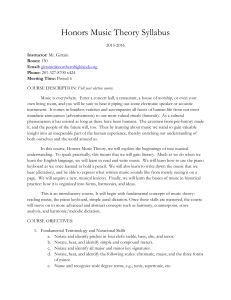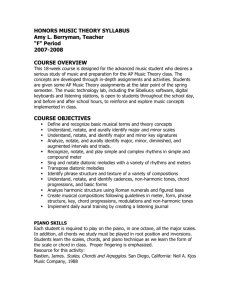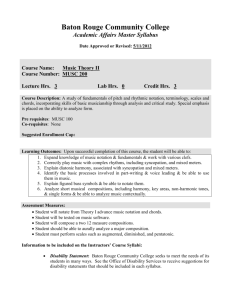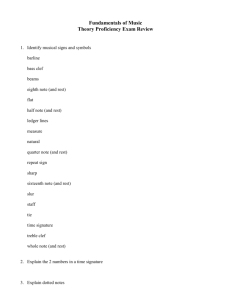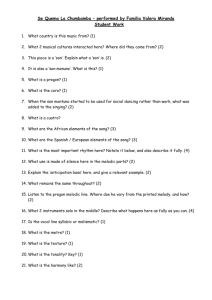Music Theory Syllabus - SCPA Music Department
advertisement
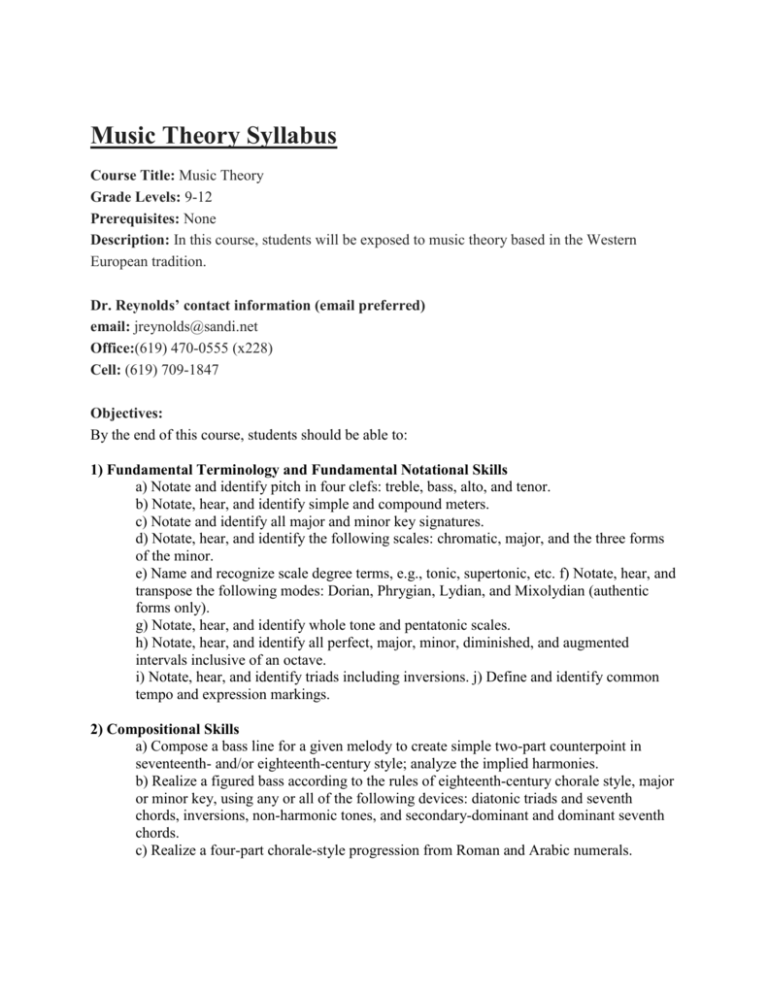
Music Theory Syllabus Course Title: Music Theory Grade Levels: 9-12 Prerequisites: None Description: In this course, students will be exposed to music theory based in the Western European tradition. Dr. Reynolds’ contact information (email preferred) email: jreynolds@sandi.net Office:(619) 470-0555 (x228) Cell: (619) 709-1847 Objectives: By the end of this course, students should be able to: 1) Fundamental Terminology and Fundamental Notational Skills a) Notate and identify pitch in four clefs: treble, bass, alto, and tenor. b) Notate, hear, and identify simple and compound meters. c) Notate and identify all major and minor key signatures. d) Notate, hear, and identify the following scales: chromatic, major, and the three forms of the minor. e) Name and recognize scale degree terms, e.g., tonic, supertonic, etc. f) Notate, hear, and transpose the following modes: Dorian, Phrygian, Lydian, and Mixolydian (authentic forms only). g) Notate, hear, and identify whole tone and pentatonic scales. h) Notate, hear, and identify all perfect, major, minor, diminished, and augmented intervals inclusive of an octave. i) Notate, hear, and identify triads including inversions. j) Define and identify common tempo and expression markings. 2) Compositional Skills a) Compose a bass line for a given melody to create simple two-part counterpoint in seventeenth- and/or eighteenth-century style; analyze the implied harmonies. b) Realize a figured bass according to the rules of eighteenth-century chorale style, major or minor key, using any or all of the following devices: diatonic triads and seventh chords, inversions, non-harmonic tones, and secondary-dominant and dominant seventh chords. c) Realize a four-part chorale-style progression from Roman and Arabic numerals. 3) Score Analysis a) Notate, hear, and identify authentic, plagal, half, Phrygian half, and deceptive cadences in major and minor keys. b) Identify in score the following nonharmonic tones: passing tone (accented and unaccented), neighboring tone, anticipation, suspension, retardation, appoggiatura, escape tone, changing tone (cambiata), and pedal tone. c) Small-scale and large-scale harmonic procedures, including: i) Identification of cadence types ii) Roman-numeral and figured-bass analysis, including nonharmonic tones, seventh chords, and secondary-dominant chords iii) Identification of key centers and key relationships; recognition of modulation to closely related keys d) Melodic organization and developmental procedures: i) Identify in score scale types and modes ii) Identify melodic patterning iii) Identify motivic development and relationships (e.g., inversion, retrograde, sequence, imitation) e) Rhythmic/metric organization: i) Identification of meter type (e.g., duple, triple, quadruple) and beat type (e.g., simple, compound) ii) Hear and identify rhythmic devices and procedures (e.g., augmentation, diminution, hemiola) f) Texture: i) Hear and identify types (e.g., monophony, homophony, polyphony) ii) Hear and identify types devices (e.g., textural inversion, imitation) 4) Aural Skills: a) Detect pitch and rhythm errors in written music from given aural excerpts. b) Notate a melody from dictation, 6 to 8 bars, MAJOR key, mostly diatonic pitches, simple or compound time, treble or bass clef, 3 to 4 playings. c) Notate a melody from dictation, 6 to 8 bars, MINOR key, chromatic alteration from harmonic/melodic scales, simple or compound time, treble or bass clef, 3 to 4 playings. d) Sight-sing a melody, 4 to 8 bars long, major or minor key, duple or triple meter, simple or compound time, treble or bass clef, using solfege, pitch names, numbers, or any comfortable vocal syllable(s). e) Hear the following nonharmonic tones: passing tone (accented and unaccented), neighboring tone, anticipation, suspension, retardation, appoggiatura, escape tone, changing tone (cambiata), and pedal tone. f) Notate the soprano and bass pitches and roman and Arabic numeral analysis of a harmonic dictation, in eighteenth-century chorale style. Features may include seventh chords, secondary dominants, major or minor key, 3 to 4 playings. Grading 100-90 = A, 89-80=B, 79-70=C, 69-60=D, 59-below=F Assignments: There will be no assigned homework for this course. There will be a midterm and a final each semester: Midterm Final Total 50 points 50 points 100 points
